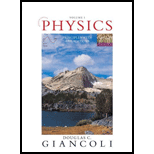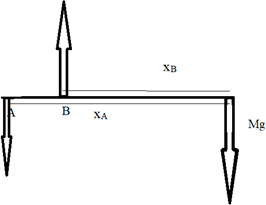
Physics: Principles and Applications -- Pearson e Text Instant Access (Pearson+)
7th Edition
ISBN: 9780137679065
Author: Douglas Giancoli
Publisher: PEARSON+
expand_more
expand_more
format_list_bulleted
Concept explainers
Question
Chapter 9, Problem 1OQ
To determine
The force exerted on the diving board at A and B.
Expert Solution & Answer
Answer to Problem 1OQ
Solution:
Option (a)FA is down, FB is up and FB is larger than FA.
Explanation of Solution
Torque can be understood as a force that tends to cause rotation.
Weight of the diver will act downwards. The reaction forces will act upwards at A and B.

Want to see more full solutions like this?
Subscribe now to access step-by-step solutions to millions of textbook problems written by subject matter experts!
Students have asked these similar questions
What are the expected readings of the ammeter and voltmeter for the circuit in the figure below? (R = 5.60 Ω, ΔV = 6.30 V)
ammeter
I =
simple diagram to illustrate the setup for each law- coulombs law and biot savart law
A circular coil with 100 turns and a radius of 0.05 m is placed in a magnetic field that changes at auniform rate from 0.2 T to 0.8 T in 0.1 seconds. The plane of the coil is perpendicular to the field.• Calculate the induced electric field in the coil.• Calculate the current density in the coil given its conductivity σ.
Chapter 9 Solutions
Physics: Principles and Applications -- Pearson e Text Instant Access (Pearson+)
Ch. 9 - Prob. 1OQCh. 9 - Describe several situations in which an object is...Ch. 9 - Prob. 2QCh. 9 - You can find the center of gravity of a meter...Ch. 9 - Prob. 4QCh. 9 - A ground retaining wall is shown in Fig. 9-36a...Ch. 9 - Can the sum of the torques on an object be zero...Ch. 9 - A ladder, leaning against a wall, makes a 60°...Ch. 9 - A uniform meter stick supported at the 25-cm mark...Ch. 9 - Why do you tend to lean backward when carrying a...
Ch. 9 - Figure 9-38 shows a cone. Explain how to lay it on...Ch. 9 - Prob. 11QCh. 9 - Why is it not possible to sit upright in a chair...Ch. 9 - Why is it more difficult to do sit-ups when your...Ch. 9 - Explain why touching your toes while you are...Ch. 9 - Prob. 15QCh. 9 - Name the type of equilibrium for each position of...Ch. 9 - (
17.
)
Is the Young's modulus for a bungee cord...Ch. 9 - Prob. 18QCh. 9 - Prob. 19QCh. 9 - A 60-kg woman stands on the very end of a uniform...Ch. 9 - Prob. 2MCQCh. 9 - Prob. 3MCQCh. 9 - Prob. 4MCQCh. 9 - Two children are balanced on opposite sides of a...Ch. 9 - Prob. 6MCQCh. 9 - Prob. 7MCQCh. 9 - Prob. 8MCQCh. 9 - Prob. 9MCQCh. 9 - Prob. 10MCQCh. 9 - Three forces are applied to a tree sapling, as...Ch. 9 - Prob. 2PCh. 9 - 3(I) A tower crane ( Fig. 9-48a) must always be...Ch. 9 - What is the mass of the diver in Fig. 9-49 if she...Ch. 9 - Prob. 5PCh. 9 - Figure 9-50 shows a pair of forceps used to hold a...Ch. 9 - Prob. 7PCh. 9 - The two trees in Fig. 9-51 are 6.6 m apart. A...Ch. 9 - Prob. 9PCh. 9 - Prob. 10PCh. 9 - Prob. 11PCh. 9 - Find the tension in the two cords shown in Fig....Ch. 9 - Prob. 13PCh. 9 - Prob. 14PCh. 9 - The force required to pull the cork out of the top...Ch. 9 - Prob. 16PCh. 9 - Three children are trying to balance on a seesaw,...Ch. 9 - A shop sign weighing 215 N hangs from the end of a...Ch. 9 - Prob. 19PCh. 9 - Prob. 20PCh. 9 - Prob. 21PCh. 9 - 22 (II) A 20.0-m-long uniform beam weighing 650 N...Ch. 9 - Prob. 23PCh. 9 - Prob. 24PCh. 9 - Prob. 25PCh. 9 - Prob. 26PCh. 9 - A uniform rod AB of length 5.0 m and mass M=3.S kg...Ch. 9 - You are on a pirate ship and being forced to walk...Ch. 9 - Prob. 29PCh. 9 - Prob. 30PCh. 9 - Prob. 31PCh. 9 - Prob. 32PCh. 9 - Prob. 33PCh. 9 - Prob. 34PCh. 9 - Prob. 35PCh. 9 - 36 (II) The Achilles tendon is attached to the...Ch. 9 - If 25 kg is the maximum mass m that a person can...Ch. 9 - Prob. 38PCh. 9 - Prob. 39PCh. 9 - Prob. 40PCh. 9 - A marble column of cross-sectional area 1.4 m2...Ch. 9 - Prob. 42PCh. 9 - A sign (mass 1700 kg) hangs from the bottom end of...Ch. 9 - Prob. 44PCh. 9 - Prob. 45PCh. 9 - Prob. 46PCh. 9 - A steel wire 2.3 mm in diameter stretches by...Ch. 9 - Prob. 48PCh. 9 - Prob. 49PCh. 9 - Prob. 50PCh. 9 - Prob. 51PCh. 9 - Prob. 52PCh. 9 - (a) What is the minimum cross-sectional area...Ch. 9 - Prob. 54PCh. 9 - Prob. 55PCh. 9 - Prob. 56PCh. 9 - Prob. 57PCh. 9 - Prob. 58GPCh. 9 - Prob. 59GPCh. 9 - Prob. 60GPCh. 9 - Prob. 61GPCh. 9 - Prob. 62GPCh. 9 - Prob. 63GPCh. 9 - Prob. 64GPCh. 9 - When a mass of 25 kg is hung from the middle of a...Ch. 9 - Prob. 66GPCh. 9 - Prob. 67GPCh. 9 - Prob. 68GPCh. 9 - Prob. 69GPCh. 9 - Prob. 70GPCh. 9 - Prob. 71GPCh. 9 - Prob. 72GPCh. 9 - Prob. 73GPCh. 9 - A 2.0-m-high box with a 1.0-m-square base is moved...Ch. 9 - Prob. 75GPCh. 9 - Prob. 76GPCh. 9 - Prob. 77GPCh. 9 - Prob. 78GPCh. 9 - In a mountain-climbing technique called the...Ch. 9 - Prob. 80GPCh. 9 - A cubic crate of side s=20m is top-heavy: its cgis...
Knowledge Booster
Learn more about
Need a deep-dive on the concept behind this application? Look no further. Learn more about this topic, physics and related others by exploring similar questions and additional content below.Similar questions
- An L-C circuit has an inductance of 0.410 H and a capacitance of 0.250 nF . During the current oscillations, the maximum current in the inductor is 1.80 A . What is the maximum energy Emax stored in the capacitor at any time during the current oscillations? How many times per second does the capacitor contain the amount of energy found in part A? Please show all steps.arrow_forwardA long, straight wire carries a current of 10 A along what we’ll define to the be x-axis. A square loopin the x-y plane with side length 0.1 m is placed near the wire such that its closest side is parallel tothe wire and 0.05 m away.• Calculate the magnetic flux through the loop using Ampere’s law.arrow_forwardDescribe the motion of a charged particle entering a uniform magnetic field at an angle to the fieldlines. Include a diagram showing the velocity vector, magnetic field lines, and the path of the particle.arrow_forward
- Discuss the differences between the Biot-Savart law and Coulomb’s law in terms of their applicationsand the physical quantities they describe.arrow_forwardExplain why Ampere’s law can be used to find the magnetic field inside a solenoid but not outside.arrow_forward3. An Atwood machine consists of two masses, mA and m B, which are connected by an inelastic cord of negligible mass that passes over a pulley. If the pulley has radius RO and moment of inertia I about its axle, determine the acceleration of the masses mA and m B, and compare to the situation where the moment of inertia of the pulley is ignored. Ignore friction at the axle O. Use angular momentum and torque in this solutionarrow_forward
- A 0.850-m-long metal bar is pulled to the right at a steady 5.0 m/s perpendicular to a uniform, 0.650-T magnetic field. The bar rides on parallel metal rails connected through a 25-Ω, resistor (Figure 1), so the apparatus makes a complete circuit. Ignore the resistance of the bar and the rails. Please explain how to find the direction of the induced current.arrow_forwardFor each of the actions depicted, determine the direction (right, left, or zero) of the current induced to flow through the resistor in the circuit containing the secondary coil. The coils are wrapped around a plastic core. Immediately after the switch is closed, as shown in the figure, (Figure 1) in which direction does the current flow through the resistor? If the switch is then opened, as shown in the figure, in which direction does the current flow through the resistor? I have the answers to the question, but would like to understand the logic behind the answers. Please show steps.arrow_forwardWhen violet light of wavelength 415 nm falls on a single slit, it creates a central diffraction peak that is 8.60 cm wide on a screen that is 2.80 m away. Part A How wide is the slit? ΟΙ ΑΣΦ ? D= 2.7.10-8 Submit Previous Answers Request Answer × Incorrect; Try Again; 8 attempts remaining marrow_forward
- Two complex values are z1=8 + 8i, z2=15 + 7 i. z1∗ and z2∗ are the complex conjugate values. Any complex value can be expessed in the form of a+bi=reiθ. Find θ for (z1-z∗2)/z1+z2∗. Find r and θ for (z1−z2∗)z1z2∗ Please show all stepsarrow_forwardCalculate the center of mass of the hollow cone shown below. Clearly specify the origin and the coordinate system you are using. Z r Y h Xarrow_forward12. If all three collisions in the figure below are totally inelastic, which will cause more damage? (think about which collision has a larger amount of kinetic energy dissipated/lost to the environment? I m II III A. I B. II C. III m m v brick wall ע ע 0.5v 2v 0.5m D. I and II E. II and III F. I and III G. I, II and III (all of them) 2marrow_forward
arrow_back_ios
SEE MORE QUESTIONS
arrow_forward_ios
Recommended textbooks for you
 College PhysicsPhysicsISBN:9781305952300Author:Raymond A. Serway, Chris VuillePublisher:Cengage Learning
College PhysicsPhysicsISBN:9781305952300Author:Raymond A. Serway, Chris VuillePublisher:Cengage Learning University Physics (14th Edition)PhysicsISBN:9780133969290Author:Hugh D. Young, Roger A. FreedmanPublisher:PEARSON
University Physics (14th Edition)PhysicsISBN:9780133969290Author:Hugh D. Young, Roger A. FreedmanPublisher:PEARSON Introduction To Quantum MechanicsPhysicsISBN:9781107189638Author:Griffiths, David J., Schroeter, Darrell F.Publisher:Cambridge University Press
Introduction To Quantum MechanicsPhysicsISBN:9781107189638Author:Griffiths, David J., Schroeter, Darrell F.Publisher:Cambridge University Press Physics for Scientists and EngineersPhysicsISBN:9781337553278Author:Raymond A. Serway, John W. JewettPublisher:Cengage Learning
Physics for Scientists and EngineersPhysicsISBN:9781337553278Author:Raymond A. Serway, John W. JewettPublisher:Cengage Learning Lecture- Tutorials for Introductory AstronomyPhysicsISBN:9780321820464Author:Edward E. Prather, Tim P. Slater, Jeff P. Adams, Gina BrissendenPublisher:Addison-Wesley
Lecture- Tutorials for Introductory AstronomyPhysicsISBN:9780321820464Author:Edward E. Prather, Tim P. Slater, Jeff P. Adams, Gina BrissendenPublisher:Addison-Wesley College Physics: A Strategic Approach (4th Editio...PhysicsISBN:9780134609034Author:Randall D. Knight (Professor Emeritus), Brian Jones, Stuart FieldPublisher:PEARSON
College Physics: A Strategic Approach (4th Editio...PhysicsISBN:9780134609034Author:Randall D. Knight (Professor Emeritus), Brian Jones, Stuart FieldPublisher:PEARSON

College Physics
Physics
ISBN:9781305952300
Author:Raymond A. Serway, Chris Vuille
Publisher:Cengage Learning

University Physics (14th Edition)
Physics
ISBN:9780133969290
Author:Hugh D. Young, Roger A. Freedman
Publisher:PEARSON

Introduction To Quantum Mechanics
Physics
ISBN:9781107189638
Author:Griffiths, David J., Schroeter, Darrell F.
Publisher:Cambridge University Press

Physics for Scientists and Engineers
Physics
ISBN:9781337553278
Author:Raymond A. Serway, John W. Jewett
Publisher:Cengage Learning

Lecture- Tutorials for Introductory Astronomy
Physics
ISBN:9780321820464
Author:Edward E. Prather, Tim P. Slater, Jeff P. Adams, Gina Brissenden
Publisher:Addison-Wesley

College Physics: A Strategic Approach (4th Editio...
Physics
ISBN:9780134609034
Author:Randall D. Knight (Professor Emeritus), Brian Jones, Stuart Field
Publisher:PEARSON
What is Torque? | Physics | Extraclass.com; Author: Extraclass Official;https://www.youtube.com/watch?v=zXxrAJld9mo;License: Standard YouTube License, CC-BY